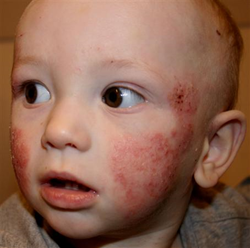Snapshot
- A 5-month-old boy is brought to urgent care for a wet rash on his cheeks. His mother reports that he has been dealing with this rash for the past few weeks, though it has gotten much worse in the past few days. She has wrapped his hands in socks to prevent scratching, especially during sleep. Family history includes childhood asthma and eczema. On physical exam, his bilateral cheeks are erythematous with oozing papulovesicles and excoriations. The physician prescribes a topical corticosteroid.
Introduction
- Clinical definition
- a chronic and pruritic inflammatory skin disease also known as eczema
- Epidemiology
- prevalence
- very common
- 10-20% prevalence
- demographics
- primarily affects children but can affect all ages
- risk factors
- family history
- living in urban setting
- Western diet
- prevalence
- Etiology
- combination of genetic, dietary, and environmental causes
- Pathogenesis
- filaggrin deficiency or dysfunction may contribute to decreased water retention, impaired tight-junction formation, and reduced ceramide content
- cutaneous inflammation with infiltrating T-cells can cause epidermal thickening, contributing to functional impairment of epidermal barrier
- Genetics
- mutations
- loss of function mutation in filaggrin (FLG) gene
- filaggrin is an epidermal structural protein
- increases risk for developing atopic dermatitis and other allergic disorders
- loss of function mutation in filaggrin (FLG) gene
- mutations
- Associated conditions
- food allergy
- Wiskott-Aldrich syndrome
- suspect when there is eczema along with recurrent infections and thrombocytopenia
- Prognosis
- majority of childhood eczema will improve or resolve as they get older
- adult eczema often evolve into chronic hand eczema
Presentation

- Symptoms
- pruritus
- may result in sleep disturbance
- excoriations from scratching
- pruritus
- Physical exam
- dry and rough skin
- acute flares
- diffuse erythematous patches and plaques with oozing and crusting papules/vesicles
- chronic lesions
- poorly demarcated patches and plaques with scales, excoriation, and lichenification
- hyperlinearity of palms or soles
- location
- commonly on skin flexures in children and adults
- commonly on the face in infancy
Studies
- Labs
- may have ↑ serum IgE
- Biopsy
- indication
- to confirm diagnosis
- indication
- Making the diagnosis
- most cases are clinically diagnosed
Differential
Treatment
- Conservative
- emollients and moisturizers
- indications
- enhances repair of epidermal barrier
- to apply soon after bathing
- indications
- emollients and moisturizers
- Medical
- topical therapy
- corticosteroids
- indication
- first-line treatment for acute flares
- indication
- calcineurin inhibitors
- indications
- for use on face, anogenital, and neck area
- for disease recalcitrant to steroids
- alternative to steroids
- drugs
- tacrolimus
- indications
- corticosteroids
- systemic therapy
- indication
- for severe or refractory atopic dermatitis
- drugs
- cyclosporine
- azathioprine
- dupilumab
- indication
- topical therapy
- Procedural
- phototherapy
- indications
- for severe or refractory atopic dermatitis
- for patients not willing to take systemic therapy for atopic dermatitis
- modalities
- ultraviolet light therapy
- indications
- phototherapy
- psoralen plus ultraviolet A (PUVA)
Complications
- Secondary bacterial infection
- Eczema herpeticum



